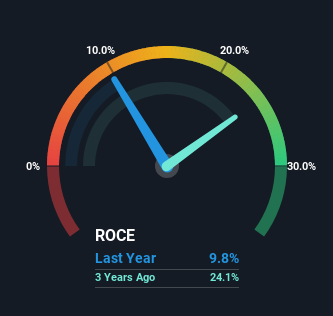Capital Allocation Trends At CoreCard (NYSE:CCRD) Aren't Ideal
Finding a business that has the potential to grow substantially is not easy, but it is possible if we look at a few key financial metrics. One common approach is to try and find a company with returns on capital employed (ROCE) that are increasing, in conjunction with a growing amount of capital employed. Ultimately, this demonstrates that it's a business that is reinvesting profits at increasing rates of return. However, after briefly looking over the numbers, we don't think CoreCard (NYSE:CCRD) has the makings of a multi-bagger going forward, but let's have a look at why that may be.
What Is Return On Capital Employed (ROCE)?
For those who don't know, ROCE is a measure of a company's yearly pre-tax profit (its return), relative to the capital employed in the business. The formula for this calculation on CoreCard is:
Return on Capital Employed = Earnings Before Interest and Tax (EBIT) ÷ (Total Assets - Current Liabilities)
0.098 = US$5.3m ÷ (US$64m - US$9.5m) (Based on the trailing twelve months to December 2023).
Therefore, CoreCard has an ROCE of 9.8%. On its own that's a low return, but compared to the average of 7.2% generated by the Software industry, it's much better.
Check out our latest analysis for CoreCard
Above you can see how the current ROCE for CoreCard compares to its prior returns on capital, but there's only so much you can tell from the past. If you'd like to see what analysts are forecasting going forward, you should check out our free analyst report for CoreCard .
How Are Returns Trending?
When we looked at the ROCE trend at CoreCard, we didn't gain much confidence. Over the last five years, returns on capital have decreased to 9.8% from 24% five years ago. Given the business is employing more capital while revenue has slipped, this is a bit concerning. If this were to continue, you might be looking at a company that is trying to reinvest for growth but is actually losing market share since sales haven't increased.
The Key Takeaway
In summary, we're somewhat concerned by CoreCard's diminishing returns on increasing amounts of capital. Investors haven't taken kindly to these developments, since the stock has declined 67% from where it was five years ago. That being the case, unless the underlying trends revert to a more positive trajectory, we'd consider looking elsewhere.
Like most companies, CoreCard does come with some risks, and we've found 3 warning signs that you should be aware of.
While CoreCard may not currently earn the highest returns, we've compiled a list of companies that currently earn more than 25% return on equity. Check out this free list here.
Have feedback on this article? Concerned about the content? Get in touch with us directly. Alternatively, email editorial-team (at) simplywallst.com.
This article by Simply Wall St is general in nature. We provide commentary based on historical data and analyst forecasts only using an unbiased methodology and our articles are not intended to be financial advice. It does not constitute a recommendation to buy or sell any stock, and does not take account of your objectives, or your financial situation. We aim to bring you long-term focused analysis driven by fundamental data. Note that our analysis may not factor in the latest price-sensitive company announcements or qualitative material. Simply Wall St has no position in any stocks mentioned.

 Yahoo Finance
Yahoo Finance 
